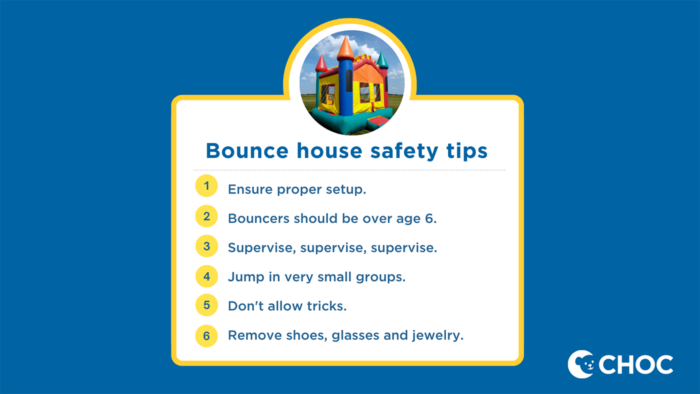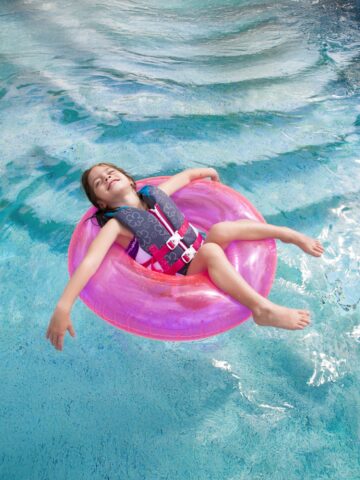The enticing, bright-colored inflatable bounce houses have become a staple in the yards of families and friends celebrating. But with many eager kids excitedly bouncing, there has been an increased prevalence of bounce-house-related injuries.
A recent CHOC-led study found that the frequency and rate of pediatric bounce house injuries has increased steadily since 2000. The report, “Distribution of Injury in Inflatable Jumping Amusements in the U.S. Over the last 20 years, the study found that kids will continue to suffer injuries in inflatable play structures unless regulators and operators strengthen injury-prevention measures and improve safety rules.
“There’s a false perception that these devices are safe,” says CHOC pediatric surgeon Dr. Saeed Awan, senior author of the report.
This study on bounce house-related injuries comes on the heels of another injury-related study on pediatric dog bites and is the latest example of how CHOC, as a recently designated Level 1 pediatric trauma center, leads the regional effort for injury prevention.
Bounce house injury statistics in recent years
The study looked at the rate of injury in children ages 2 to 17 from 2000 to 2019.
Breaking the data into five-year periods, the researchers found that bounce houses injured 82,748 kids from 2015–19, compared with only 5,599 from 2000–2004.
Researchers report that the number of bounce-house injuries increased fifteenfold from 1995 to 2010, and they warn that the rate could rise further as at-home inflatable devices become more widely available.
“Although healthcare providers and parents have articulated concerns related to the use of inflatable devices for almost 30 years, these warnings have gone unnoticed,” the report said.
The team of researchers from the CHOC Research Institute determined that although most bounce-house injuries (96.4%) are minor enough to allow for patient discharge from the ED, more industry regulation and community education is needed to keep kids from getting hurt from being struck while inside the inflatable play structure, falling out of it (35.8%), or a combination of the two.
Some key findings of the bounce house study:
- Boys (53.9%) are more likely to get hurt than girls (46.1%).
- The most reported injuries were fracture (25.8%), muscle strain (25.7%), and contusion (14.5%).
- Most kids (around 96%) were hurt in bounce houses at their homes.
- The lower extremities were the most prevalent area of injury.
- Although rare in both kids under 6 as well as over 6, concussion was almost twice as likely to occur in the older age group.
- Most injuries (70%) occur from May to October.
The study noted that, unlike trampolines and other similar devices, bounce houses still lack substantial medical research and clear public-policy guidance on safety. No federal safety regulations for bounce houses currently exist — they differ by manufacturer and policies can vary by state.
Get safety tips for trampolines from CHOC experts.
According to the report, a child’s risk of injury increases when adults supervise ineffectively, when the number of participants exceeds the device’s limits, and when children of different ages and weights use the bounce house together.
How to keep your kids safe in bounce houses
Our experts suggest choosing a safer activity for your child, whether at home, at a party, or in the community. But if your child must bounce, consider the following safety tips:
1. Ensure proper setup.
Make sure the bounce house meets safety requirements—such as secure tie-downs to prevent it from blowing away in high winds, proper inflation, and adherence to weight limits—and place it in an open area away from trees and power lines. The bounce house should have a wide enough opening to allow parents to easily supervise and access it in an emergency.
2. Prevent children under age 6 from bouncing.
Young children do not have the proper coordination to avoid landing in awkward positions.

 Print this chart
Print this chart
3. Supervise, supervise, supervise.
Make sure that there is a trusted adult always supervising your children. If bouncing in a public place, don’t count on others to properly supervise. Supervision may not prevent injuries, but it helps ensure your child jumps as safely as possible.
4. Jump in very small groups.
One jumper in a bounce house is ideal to avoid injury. But if other kids are eager to participate, make sure they jump in small groups of four kids or less — and that all are of the same size and weight. This can prevent smaller kids from being overjumped and falling awkwardly. Preteens, teens and adults should be prohibited from bouncing. Never overcrowd the bounce house.
5. Don’t allow tricks.
Do not allow your children to engage in horseplay or do somersaults or flips.
6. Remove shoes, glasses and jewelry.
Children should remove any clothing, accessories or sharp objects from their pockets when entering the bounce house.
Get more expert health advice delivered to your inbox monthly by subscribing to the KidsHealth newsletter here.
Get more safety and injury prevention tips from CHOC experts
More children are affected by injuries than all other childhood illnesses and diseases combined. Most of these injuries are predictable and preventable. Here’s how to keep your child safe.





